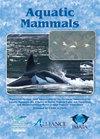年龄和性别对圈养海獭能量摄入的影响:对圈养管理和物种保护的影响
IF 0.8
4区 生物学
Q4 MARINE & FRESHWATER BIOLOGY
引用次数: 0
摘要
海獭(Enhydra lutris)是众所周知的生态系统工程师,由于它们的高摄取量,对海带森林和岩石潮间带群落产生了重大影响。量化海獭的食物生物量和能量摄入量是了解海獭种群对生态系统的潜在生态影响、预测未来种群趋势和扩张潜力的重要途径。虽然野生海獭的详细、精细、特定年龄的食物摄入量很难量化,但从人类照顾的海獭身上可以获得丰富的潜在信息。这项研究使用了温哥华水族馆30多年来收集的10只海獭的饲养记录中的食物和能量摄入数据。在这些饲养记录中,记录每日食物生物量摄入量和体重测量值,并将其转换为年平均食物质量和总能量摄入量(GEI)。年龄、性别和人群的特定趋势也被观察到。幼海獭的相对摄食质量最高,相当于体重的~26%,成年海獭的相对摄食质量降至~20%。幼年水獭同样具有最高的质量特异性GEI,从接近出生到第1年的测量值比第3年(性成熟和身体成熟的年龄)高出约40%。两性之间的趋势也存在关键差异。圈养的成年雄性海獭比雌性海獭大25 - 42%,GEI比雌性海獭高23 - 58%,尽管所有年龄段雄性和非生殖雌性海獭的群体特定GEI几乎相同,稳定在~650 kJ kg-1 d-1。尽管摄取的食物量很高,但GEI仅比其他圈养海洋哺乳动物高5%至15%,与以前对野生海獭的估计相当。在模拟海獭种群的生态影响和考虑未来环境变化的潜在影响时,这些摄入食物量和能量摄入需求的估计是有价值的。本文章由计算机程序翻译,如有差异,请以英文原文为准。
The Effects of Age and Sex on the Energy Intake of Captive Sea Otters (Enhydra lutris): Implications for Captive Management and Species Conservation
Sea otters (Enhydra lutris) are known ecosystem engineers that have significant impacts on their kelp forest and rocky intertidal communities due to their high levels of food intake. Quantifying sea otter food biomass and energy intake is a valuable way to understand potential ecological impacts of sea otter populations on ecosystems and for predicting future population trends and potential for expansion. While detailed, fine-scale, age-specific food intake is difficult to quantify in wild sea otters, there is a wealth of potential information available from otters under human care. This study used food and energy intake data from husbandry records of 10 sea otters collected over three decades at the Vancouver Aquarium. Within these husbandry records, daily food biomass intake and body mass measurements were recorded and converted to annual average food mass and gross energy intake (GEI). Age-, sex-, and mass-specific trends were also observed. Young sea otters had the highest relative ingested food mass, equivalent to ~26% of body mass, which decreased to ~20% in adult otters. Young otters similarly had the highest mass-specific GEI, where measures from near birth to year 1 were ~40% higher than at year 3, the age of sexual and physical maturity. There were also key differences in trends between sexes. Captive adult male sea otters were 25 to 42% larger than females and their GEI was 23 to 58% higher, although mass-specific GEI was almost identical for male and non-reproductive female otters at all ages, plateauing at ~650 kJ kg-1 d-1. Despite high levels of ingested food mass, GEI was only 5 to 15% higher than for other captive marine mammals and was comparable to previous estimates for wild sea otters. These estimates of ingested food mass and energy intake requirements are valuable when modelling the ecological impact of sea otter populations and for considering the potential effects of future environmental changes.
求助全文
通过发布文献求助,成功后即可免费获取论文全文。
去求助
来源期刊

Aquatic Mammals
MARINE & FRESHWATER BIOLOGY-ZOOLOGY
CiteScore
1.60
自引率
16.70%
发文量
99
审稿时长
>12 weeks
期刊介绍:
Aquatic Mammals is a peer-reviewed journal sponsored by the European Association for Aquatic Mammals (EAAM), the Alliance of Marine Mammal Parks and Aquariums (AMMPA), and the International Marine Animal Trainers’ Association (IMATA). Aquatic Mammals publishes articles related to marine mammals (whales, dolphins, seals, fur seals, sea lions, walrus, dugongs, manatees, sea otters, and polar bears). Topics of publication on both captive animals and wild marine mammals include aspects of husbandry; behavior; conservation; veterinary medicine; anatomy; physiology; training; population trends; and the effects of pollution, climate change, and noise.
 求助内容:
求助内容: 应助结果提醒方式:
应助结果提醒方式:


